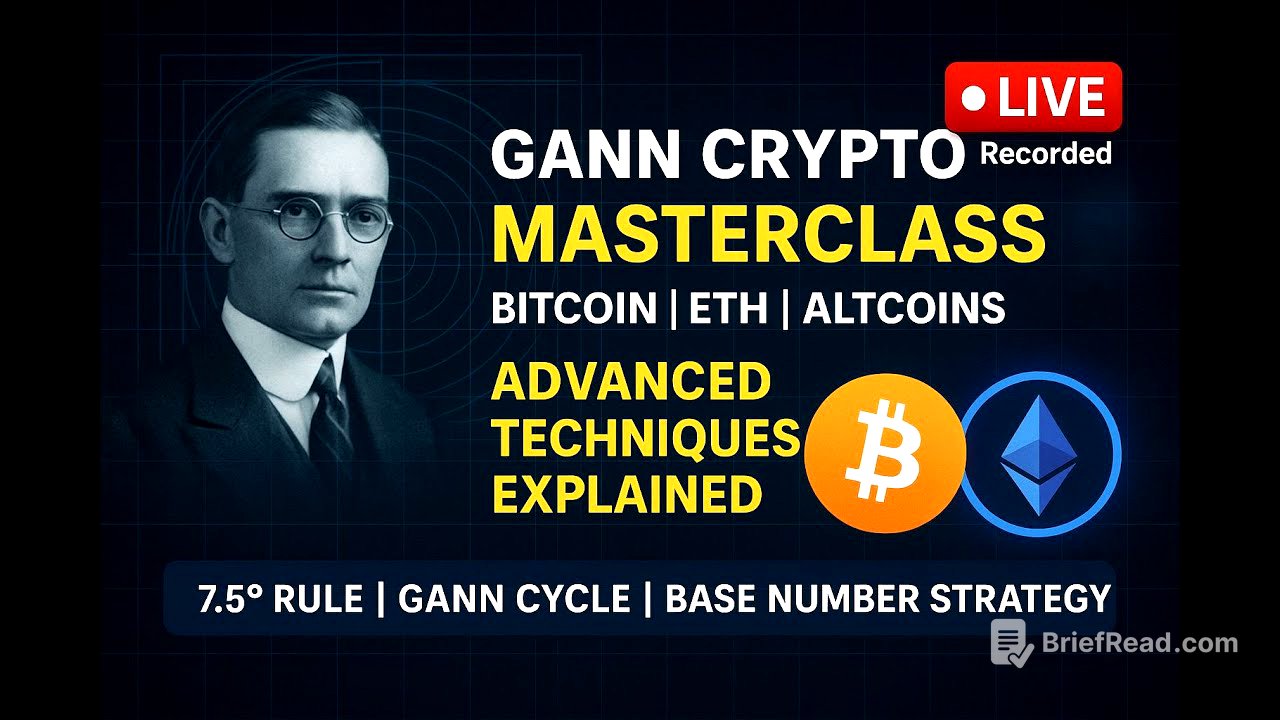TLDR;
This YouTube video provides an introduction to WD Gann's trading techniques, focusing on their application in cryptocurrency analysis. It covers three basic yet powerful methods: the 7.5-degree trading technique, cycle trading, and base number trading. The presenter emphasises the importance of dedication and a deep understanding of these methods for successful trading, drawing parallels to real-life scenarios to illustrate the need to filter out "fake" information and focus on proven strategies. The video also touches on the broader aspects of Gann's work, including timing analysis and the integration of price, time, velocity, and space in determining market trends.
- Introduction to WD Gann's trading techniques for crypto analysis.
- Explanation of three methods: 7.5-degree trading, cycle trading, and base number trading.
- Emphasis on dedication, understanding, and filtering information for successful trading.
Introduction to the Session [0:00]
The presenter, Ranjan from Smart Finance, introduces the session, highlighting that the company is based in Chennai and has been developing unique courses and software for trend analysis since 2005. The session will focus on WD Gann's methods suitable for crypto analysis, using simple yet powerful techniques applicable for day trades, option trades, and identifying breakout levels. Those interested can join separate Hindi sessions.
Overview of WD Gann Studies [2:17]
The session will cover three basic WD Gann techniques: 7.5-degree trading, cycle trading, and base number trading. WD Gann's studies are divided into groups: square principle (square of 9, 12, 54), patterns (GAN angle studies, price to price squaring, cycle trading), and geometrical figures (hexagon, tetrahedron, pentagon). The studies progress to timing analysis using lunar and solar node methods. The presenter references a past session on lunar nodes with accompanying Excel sheets.
The Importance of Focused Study [5:08]
The presenter uses an analogy of receiving a fake currency note to illustrate the importance of focusing on reliable studies in the capital market. Many "fake" strategies promise easy profits without effort, but true success requires hard work, developing a personal model, and sticking to it. The presenter shares his 20-year involvement with GAN studies, noting that continuous innovation and adaptation are necessary, especially when applying these methods to modern instruments like cryptocurrencies.
7. 5 Degree Trading Technique [12:14]
The 7.5-degree technique is explained, noting that in GAN study, 1 degree equals 4 minutes, making 7.5 degrees equivalent to 30 minutes, the smallest cycle in a financial instrument. Support and resistance lines calculated from the previous day's close or current day's open can act as breakout points to reach a 90-degree target. This concept is replicated in GAN angle studies and price-to-price square actions. The presenter explains that 7.5 degrees is taken because 30 minutes is the smallest price cycle and relates to the Earth's rotation.
Practical Application of 7.5 Degree Technique [15:16]
The presenter demonstrates the 7.5-degree technique using Bitcoin's opening price, calculating resistance and support levels using a formula involving the square root of the price and subtracting the 7.5-degree factor. He explains how GAN converted numbers to degrees in three ways: square, hexagon, and universal principles. The presenter shows how to compute supports and resistances till 360 degrees in an Excel sheet.
Analysing Bitcoin with 7.5 Degree Technique [20:33]
The presenter compares calculated prices with Bitcoin's actual price movements, noting that most prices align with spikes or falls with a small deviation. He identifies potential high and low points based on the calculations. The presenter concludes that prominent angles like 60, 45, and 90 degrees are more suitable due to their presence in strong or weak angle territories. He advises waiting for a 15-degree price crossover or support breakdown to enter a trade, trailing stop losses to prominent angles.
Applying 7.5 Degree Technique to Ethereum [27:21]
The presenter applies the 7.5-degree technique to Ethereum, calculating breakout points and potential support and resistance levels based on the current price. He advises taking a picture of the calculations and comparing them with the price movements throughout the night. The presenter notes that this method is suitable for instruments with over 30% annual volatility, making it ideal for cryptocurrencies but not for gold or low-volatility stocks.
Cycle Trading Techniques [31:13]
The presenter explains cycle trading, defining a cycle as any activity that repeats in a frequency of time. In GAN cycle trading, 360 degrees is considered a full cycle. For BTC, which trades 24 hours, every hour corresponds to 15 degrees. The presenter explains how to calculate cycle degrees based on the number of trading hours left in the day.
Practical Application of Cycle Trading [33:52]
The presenter discusses how to use cycle trading, differentiating between static and dynamic cycles. He explains that while a static cycle divides the 24-hour period equally, a dynamic cycle accounts for the hours lapsed in the trading day. Using Bitcoin as an example, he calculates the cycle degrees based on the remaining trading hours and identifies potential entry points and targets.
Base Number Trading Techniques [41:44]
The presenter introduces base number trading, explaining that every price has a base. To find the base number, take the square root of the price repeatedly until it reduces to a single-digit number. This base number is then multiplied by 7.5 degrees and its multiples to find resistance and support levels. The presenter demonstrates the method using Bitcoin and Ethereum, explaining how to identify entry points and targets.
Conclusion and Additional Resources [46:59]
The presenter concludes by offering the Excel sheet used in the session to registered participants for testing and feedback. He highlights a structured and cost-effective GAN course available in English and Hindi, emphasising the importance of mastering one skill perfectly, be it GAN, Fibonacci, or Elliot. The presenter encourages viewers to learn GAN, highlighting its unique timing analysis capabilities. He contrasts GAN's 80-85% success rate with the lower accuracy of technical indicators and oscillators.
The Essence of Trading and Life [55:55]
The presenter shifts to a philosophical discussion, asserting that trading should not be a stressful activity and that aligning with nature is key to success. He uses the analogy of needing to ask for water when thirsty to illustrate the importance of affirming one's needs and desires. The presenter shares a thought experiment about tracing one's lineage back 15 generations to highlight the immense potential and inherent value each individual possesses.
WD Gann's Perspective on Market Analysis [1:02:42]
The presenter discusses WD Gann's advanced thinking, noting that Gann viewed price and time as moving in four dimensions—price, time, velocity, and space—rather than just two. He contrasts this with conventional analysis that focuses on price, time, and volume. The presenter explains that velocity refers to volatility, while space represents human thought and behaviour, including greed and fear.
Lunar Node and Closing Remarks [1:05:54]
The presenter mentions a lunar node method and a file from a past session in January, which predicted instability and unrest in 2025. He promises to share the file in the group. The presenter concludes by reiterating the importance of learning and applying GAN methods, noting that specific cycles can indicate periods of panic or other market behaviours.









